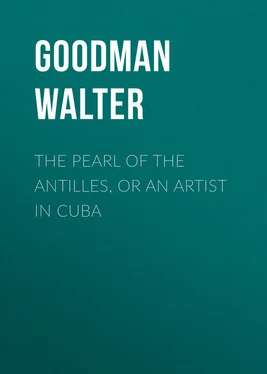Walter Goodman - The Pearl of the Antilles, or An Artist in Cuba
Здесь есть возможность читать онлайн «Walter Goodman - The Pearl of the Antilles, or An Artist in Cuba» — ознакомительный отрывок электронной книги совершенно бесплатно, а после прочтения отрывка купить полную версию. В некоторых случаях можно слушать аудио, скачать через торрент в формате fb2 и присутствует краткое содержание. Жанр: foreign_antique, foreign_prose, Путешествия и география, на английском языке. Описание произведения, (предисловие) а так же отзывы посетителей доступны на портале библиотеки ЛибКат.
- Название:The Pearl of the Antilles, or An Artist in Cuba
- Автор:
- Жанр:
- Год:неизвестен
- ISBN:нет данных
- Рейтинг книги:4 / 5. Голосов: 1
-
Избранное:Добавить в избранное
- Отзывы:
-
Ваша оценка:
- 80
- 1
- 2
- 3
- 4
- 5
The Pearl of the Antilles, or An Artist in Cuba: краткое содержание, описание и аннотация
Предлагаем к чтению аннотацию, описание, краткое содержание или предисловие (зависит от того, что написал сам автор книги «The Pearl of the Antilles, or An Artist in Cuba»). Если вы не нашли необходимую информацию о книге — напишите в комментариях, мы постараемся отыскать её.
The Pearl of the Antilles, or An Artist in Cuba — читать онлайн ознакомительный отрывок
Ниже представлен текст книги, разбитый по страницам. Система сохранения места последней прочитанной страницы, позволяет с удобством читать онлайн бесплатно книгу «The Pearl of the Antilles, or An Artist in Cuba», без необходимости каждый раз заново искать на чём Вы остановились. Поставьте закладку, и сможете в любой момент перейти на страницу, на которой закончили чтение.
Интервал:
Закладка:
To oblige our worthy friend Don Benigno we are, upon another occasion, induced to paint and embellish his quitrin – a two-wheeled carriage of the gig class, the component parts of which bear one to the other something of the proportions of a spider and his web; the body of the conveyance being extremely small, the shafts inconceivably long, and the wheels of a gigantic circumference. The street-doors of most Cuban houses are constructed with a view to the admittance of such a vehicle, which when not in use is carefully enveloped in brown holland, like a harp or a chandelier during the out-of-town season, and is deposited in the hall or passage of the threshold, and in some cases in a corner of the marble-paved reception room. The presence in our studio of Don Benigno's quitrin is therefore not very remarkable. Many weeks, however, elapse before we can get rid of this unsightly piece of furniture. Several coats of paint and varnish have to be applied, and innumerable coloured lines introduced, before it is ready to receive the more artistic touches. All devices connected with painting are by our Cuban patrons generalised under the head of 'paisaje' or landscape, and in the present instance the landscapes include two views of Don Benigno's crest together with his elaborate monogram.
A couple of mulatto art-aspirants whom we graciously receive as disciples for one hour daily, help considerably in this undertaking, and take such an especial delight in it that it is a sorrowful day for them when Saturnine – Don Benigno's black postilion – comes to wheel away their handiwork.
CHAPTER IV.
A CUBAN 'VELORIO.'
To be summoned from his couch at all hours of the night is not an uncommon occurrence with a medical man, but for a follower of 'the divine art of Apelles' to be thus disturbed in his slumbers is, to say the least of it, an unreasonable proceeding.
Nevertheless one of us must rise and don his clothes at three A.M.; for a black varlet has come to inform us that his 'amo,' Don Pancho Agüerro y Matos, has just died, and that his bereaved family are desirous of preserving his image on canvas. Nicasio and I, as usual, draw lots for the questionable privilege of immortalising the late lamented, and as this time I am the unfortunate winner, it behoves me to gather together the implements of our craft, attire myself in my darkest garments, and follow the sombre messenger of death to the house of mourning.
Here a 'velorio,' or night-wake, for the departed is being held. The reception room is already crowded with the defunct's relatives and dearest friends, who are seated on chairs and low stools against the walls. As soon as I appear everybody rises in accordance with the polite custom of the country, and the chief mourners crowd around me and give expression to their grief in a variety of ways. Some clasp my neck and waist; others cling to my legs, and pointing to an adjoining chamber, they beseech me to restore the late lamented to life – on canvas.
Encompassed as I am, it is no easy matter to reach the apartment where the deceased, surrounded by long wax candles and tall silver candlesticks, lies in state.
Though my duties are confined to the portrayal of the inanimate face before me, I often pause to take mental as well as pictorial notes of the surroundings. I observe that the defunct is attired in a suit of black, which has doubtless been provided by the undertakers; for the clothes are much too wide for his wasted anatomy, and give him the appearance of a misfitted dissenting minister. I remark that the dead man's relatives and friends bear their loss bravely; for some are endeavouring to drown their sorrows in the cup that cheers, and in lively conversation. I am reminded of the popular theory that tobacco is a disinfectant, from the fact that most of the company, including the elderly ladies, are indulging in that luxury. Occasionally a tray of cigars is handed round together with coffee, chocolate, sweetmeats, and biscuits. I note that these convivialities are only interrupted when a visitor is announced. That upon these occasions the mourners are inspired to give loud expression to their grief. That the women shriek, rave, and occasionally vary their proceedings by swooning and going into hysterics. I observe that the new arrival is seized and surrounded as I had been and conducted into the chamber of death, where some of the mourners give vent to their sorrow by clasping the clerical-looking clothes or embracing the borrowed boots. I find that among the lady mourners the most demonstrative is Doña Dolores, who is said to be the nearest surviving relative of the departed; though from the language which she occasionally utters it is not clear to me what kind of relationship she claims.
Whenever a new mourner appears, Doña Dolores, who has been hitherto silently seated behind me, springs to her feet and in the following terms apostrophises the dead:
'Oh! Pancho. My little dear! (the defunct was a middle-aged gentleman). Answer me, my love. Where are you, my brother? Ah! it's all over with you now, Panchito. To-morrow you will be quite alone, with nobody to speak to you. Oh! my Panchito – my love – my life – my entraños! Pancho of my heart; of my soul! My brother – my son – my love – my father; for thou hast been more than father, lover, son, and brother to me!'
After a short pause the lady breaks out afresh:
'Virgen Santísima! Virgen de la Caridad! Where is my poor Panchito? What have you done with him? Where are you, Pancho? Answer me, my love! Maria Santísima; look at my poor brother all alone without the power to speak or rise! Make him answer me! Oh! my dear companion – my cousin – my godfather – mi compadre – my parent – my friend; speak! Tell me where you are! Come to me, my Pancho; my Panchito. Oh! Pancho – Pan-cho! Pa-n-n-cho!!'
Once, in the middle of the lady's eloquence, the late Don Pancho startles everybody (myself included) by opening his mouth and drooping his head!
In order to facilitate my operations, the body had been propped up in a sitting posture, but by some mishap the props had given way. Until the real cause of the displacement is made manifest, Doña Dolores is beside herself with joy. Her Pancho has been restored to life! Her beloved 'stepfather, spouse, and compatriot' will drive with her to the Alameda to-morrow! He shall have a cigar and a cup of coffee now, and his portrait shall not be painted!
'Go,' says the Señora to me in a tone of authority; 'we don't want you any more. Panchito will accompany me to the photographer's, and save you the trouble!'
Fortunately the lady's friends intercede at this moment; for finding that I do not obey her commands, the exasperated Señora makes a wild dash at my sketch-book; over-turning in her movements my box of colours and one of the long candlesticks! Convinced, however, of the truth, the poor lady is pacified, and resumes her place behind me.
On the morning of the second day of the velorio, as I am putting the finishing touches to my sketch, certain strange ceremonies are observed.
An undertaker's man is announced, and, apparently with no other object in view than to provide becoming robes of sable for the bereaved, proceeds to take the general dimensions of everybody present. But I observe that a separate length of white tape is employed in each case, and that when a sufficient number have been thus collected, the measures are consigned to the dead man's pockets, together with the mourners' white cambric handkerchiefs.
When these and other curious ceremonials – the precise object of which I cannot for the life of me penetrate – have been enacted, more undertakers arrive and proceed to prepare the body for decent burial. There is much lamentation when the coffin is finally borne from the house. The women shriek and swoon, grovel on the ground, and tear their hair. As for Doña Dolores – she is inconsolable, and continues to harangue the remains until her speech is inarticulate and she is carried away in a fainting condition to her chamber.
Читать дальшеИнтервал:
Закладка:
Похожие книги на «The Pearl of the Antilles, or An Artist in Cuba»
Представляем Вашему вниманию похожие книги на «The Pearl of the Antilles, or An Artist in Cuba» списком для выбора. Мы отобрали схожую по названию и смыслу литературу в надежде предоставить читателям больше вариантов отыскать новые, интересные, ещё непрочитанные произведения.
Обсуждение, отзывы о книге «The Pearl of the Antilles, or An Artist in Cuba» и просто собственные мнения читателей. Оставьте ваши комментарии, напишите, что Вы думаете о произведении, его смысле или главных героях. Укажите что конкретно понравилось, а что нет, и почему Вы так считаете.












